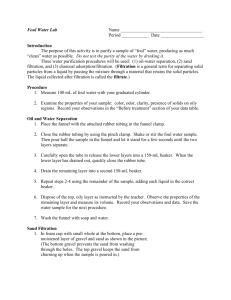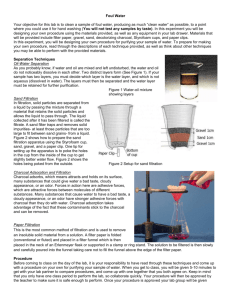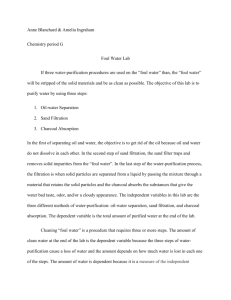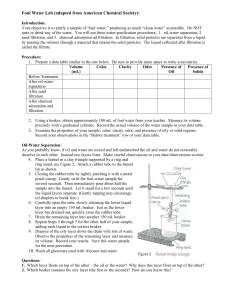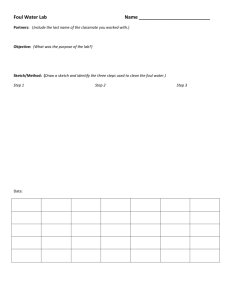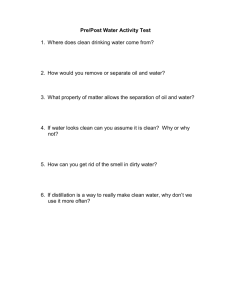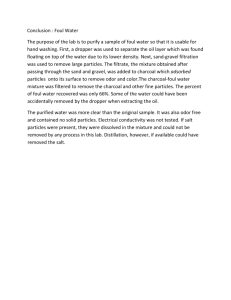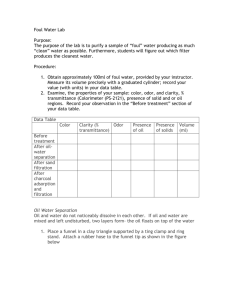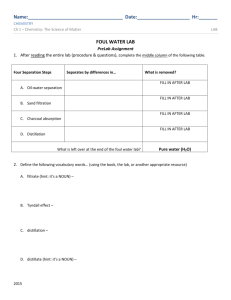Lab 7: Foul Water
advertisement
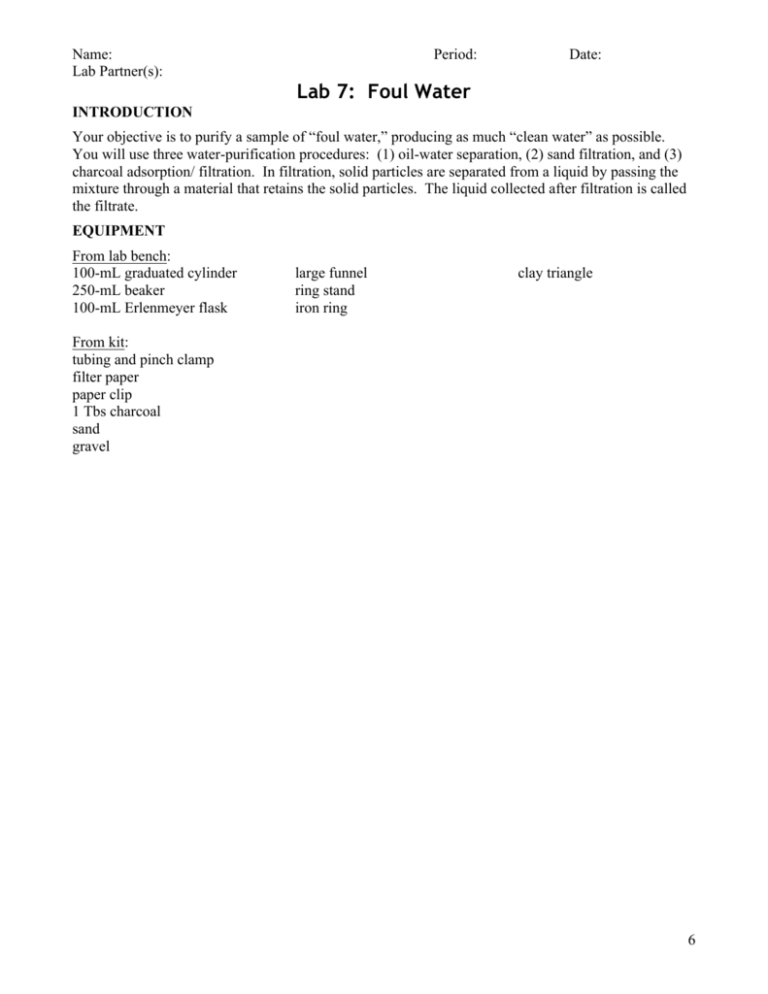
Name: Lab Partner(s): Period: Date: Lab 7: Foul Water INTRODUCTION Your objective is to purify a sample of “foul water,” producing as much “clean water” as possible. You will use three water-purification procedures: (1) oil-water separation, (2) sand filtration, and (3) charcoal adsorption/ filtration. In filtration, solid particles are separated from a liquid by passing the mixture through a material that retains the solid particles. The liquid collected after filtration is called the filtrate. EQUIPMENT From lab bench: 100-mL graduated cylinder 250-mL beaker 100-mL Erlenmeyer flask large funnel ring stand iron ring clay triangle From kit: tubing and pinch clamp filter paper paper clip 1 Tbs charcoal sand gravel 6 PROCEDURE 1. Obtain 100 mL of foul water. Record the volume in your data table. (Your teacher has already measured the volume; no need to re-check) 2. Examine the properties of your sample: color, clarity, odor, and presence of oily or solid regions. Record your observations in the “Before treatment” section of your data table. Oil-Water Separation As you probably know, oil and water don’t mix very well; instead, two layers form. Which layer floats on top of the other? You will make observations during the following procedure to check your answer. 3. Place a funnel in a clay triangle supported by a ring and ring stand (see figure). Attach a rubber tube to the funnel tip as shown. 4. Close the rubber tube by tightly pinching it with the metal pinch clamp. Gently swirl the foul-water sample for several seconds to suspend the solids. Then immediately pour about half the sample into the funnel. BE CAREFUL NOT TO SLOSH OVER THE FUNNEL EDGE! Let The liquid stand for a few seconds in the funnel until the liquid layers separate. (Gently tapping may encourage oil droplets caught in the funnel stem to break free.) 250-mL beaker 5. Carefully open the tube, slowly releasing the lower liquid layer into an empty 250-mL beaker. Just as the lower layer has drained out, quickly close the rubber tube. 6. Drain the remaining (upper) layer into a paper cup. 7. Repeat Steps 4-6 for the other half of your sample, adding each liquid to the correct beaker. 8. Which beaker contains the oily layer? ____________________Which layer is smellier? 9. Dispose of the oil layer in the trash. Observe the properties of the remaining layer, measure its volume, and record on the Data table. Save this water sample for the next step. Sand Filtration. A sand filter traps and removes solid impurities—at least those particles too large to fit between sand grains—from a liquid. 10. Using a straightened paper clip or pencil, poke small holes in the bottom of a paper cup. Add gravel and pre-moistened sand layers to the cup as shown. (the bottom layer of gravel prevents the sand from washing through the holes. The top layer of gravel keeps the sand from churning up when the water sample is poured into the cup). 11. Gently pour the liquid sample to be filtered into the prepared cup; use a stirring rod to guide flow. Catch the filtrate (filtered water) in a clean 250-mL beaker as it drains through. 12. Observe and record the properties of the filtered water sample and measure its volume. Charcoal Adsorption/Filtration. Charcoal adsorbs (attracts and holds on its surface) many substances that could give water a bad taste, odor, or cloudy appearance. 7 13. Fold a piece of filter paper as shown. Place the folded filter in a funnel and wet it slightly so it clings to the inside of the cone. BE CAREFUL NOT TO TEAR THE WET FILTER PAPER. 14. Place the funnel in a clay triangle supported by a ring clamp. Lower the ring clamp so the funnel stem extends 2-3 cm inside a 100-mL beaker. 15. Add about one tablespoon of charcoal to your water sample, stir, then let it sit for 2 minutes with occasional stirring. Pour the water sample into the flask. Swirl vigorously for a few seconds. Then gently pour the liquid through the filter paper. KEEP THE LIQUID LEVEL BELOW THE TOP OF THE FILTER PAPER! 16. If the filtrate is darkened by small charcoal particles, refilter the liquid through a clean piece of moistened filter paper. 17. When you are satisfied with the appearance and odor of your water sample, pour it into a graduated cylinder. Record the final volume and properties of the purified sample. 18. Test the conductivity of your purified water, as directed by your teacher. Cleanup 19. Dispose of liquids down the drain, solids in the trash. Place dirty glassware in dishpan, get clean replacements from your teacher. Wash your hands before leaving the lab. Name: Lab Partner(s): Period: Date: Lab 7: Foul Water PRE-LAB QUESTIONS 1. What three water purification techniques will you use? 2. Define “filtrate”. 3. After you separate the oil and water layers, a. what will you do with the oil portion? b. what will you do with the water portion? 4. If your filtrate has bits of charcoal in it, what do you do? 8 DATA: Foul Water Observations Volume, ml Color Clarity Odor Presence of Oil Presence of Solids Before treatment After oilwater separation After sand filtration After charcoal and filtratn Results of Conductivity Testing: Calculations: 1. What percent of your original foul water sample did you recover as purified water? % of water recovered = volume of water purified x 100 = volume of foul water sample 2. What volume of liquid did you lose during purification? 3. What percent of your original foul water sample was lost during purification? Data Analysis 1. What were percent recovery data of all lab groups in your class? 2. Construct a histogram showing percent recovery obtained by all lab groups in your class. (Graph paper on last page of this packet.) 9 3. What was a. the largest percent recovery obtained by a lab group? b. the smallest? c. What is the range of percent recovery? 4. What was the mean percent recovery? 5. What was the median percent recovery? Questions 1. Is your “purified water” sample “pure” water? How do you know? 2. Suggest how you might compare the quality of your water sample with that of other lab groups. That is, how can the relative success of each group be judged? 3. How would you improve the water-purification procedures you followed so that a higher percent of purified water could be recovered? 4. Estimate the total time you expended in purifying your water sample: a. In your view, did that time investment result in a large enough sample of sufficiently purified water? b. In the real world, it is often said that “time is money.” i. If you spent twice as much time in purifying your sample, would that extra investment in time “pay off” in higher-quality water? ii. If you spent about ten times as much time? Explain. 5. Municipal water-treatment plants do not use distillation to purify the water. Why? 10
